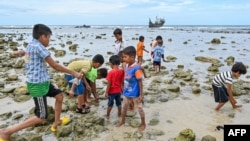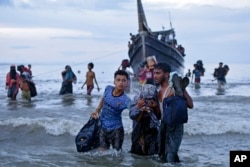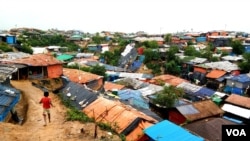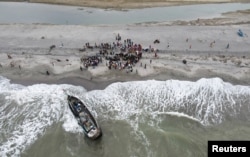The number of Rohingya taking risky boat trips across the Andaman Sea to flee mounting hunger and hopelessness in the refugee camps of Bangladesh this year has topped last year’s numbers and could keep rising, rights groups and aid agencies told VOA.
The Office of the U.N. High Commissioner for Refugees said in a statement that a boat with 150 Rohingya on board landed in western Indonesia Saturday morning. Amnesty International’s Indonesia office told VOA it had confirmed the landing as well.
That brings the total number of Rohingya fleeing across the Andaman by boat to 3,722 so far this year, according to the UNHCR. In its statement, the refugee agency said it had also received several reports of two more boats with a combined 400 or so passengers still adrift in the Andaman with broken engines; the agency issued an urgent search and rescue call to countries in the region.
The UNHCR counted 3,705 Rohingya who attempted the sea journey in all of 2022, at the time the most for any year since 2015.
Ahead of the latest landing in Indonesia, aid and advocacy groups told VOA that this year’s numbers could, or likely would, keep rising. December falls in the middle of the annual sailing season, when waters are relatively calm and most Rohingya typically make the attempt.
“We can’t predict what is going to happen in December, but if we look at last year, 2022, the last three months were the ... busiest,” UNHCR spokesman Babar Baloch said.
More to come
Nearly 1 million ethnic Rohingya, a predominantly Muslim minority from Buddhist-majority Myanmar, now live in the sprawling refugee camps of eastern Bangladesh. Most arrived in 2017, fleeing what the U.N. calls a campaign of “genocidal intent” by the Myanmar military.
Most of those fleeing the camps by boat try to make it across the Andaman to Malaysia or Indonesia, both Muslim-majority countries. Several hundred have died attempting the voyage on overcrowded vessels that often are old and rickety. Entire boats packed with refugees are believed to have been lost at sea.
“I believe there will be a lot more people on the way, but to [give] a figure ... is impossible,” Chris Lewa of the Arakan Project, a group that closely tracks the boats, told VOA.
Given the trends, “I predict that there will be more coming,” agreed Usman Hamid, Amnesty International’s country director for Indonesia.
The aid and advocacy groups, and refugees themselves, ascribe the rising numbers most of all to conditions worsening in the camps and to hopes fading that the Rohingya will be able to return safely to Myanmar anytime soon.
Myanmar by and large denies the Rohingya citizenship and was pitched into a nationwide civil war by a 2021 military coup. In the sealed camps of eastern Bangladesh, meanwhile, refugees complain of rising gang violence, a dearth of jobs and schools, and meager food rations. The U.N. World Food Program, the main source of food aid for the refugees, cut the value of its monthly vouchers in the camps in June, for the second time this year, to an average of $8 per person. It blamed a shortfall in donor support.
Like tossing a coin
“In this uncertainty of future and in this dangerous situation in the camps, where there is extortion and gang violence and insufficient rations and unemployment and no educational opportunity, all these things [are] driving the people to take the dangerous sea journeys,” said Mohammed Rezuwan Khan, a Rohingya refugee and advocate living in the camps.
He said that his sister and niece fled the camps by boat last year, making it to Indonesia, and that they all knew the risks.
“But when people have no other option, when people cannot travel by passport like any other people in the world, when people have no hope of going back to Myanmar anytime soon within the coming years, when people have lots of suffering in the camp, then the journey becomes the last and irrevocable option,” Khan said.
“It is like tossing a coin,” he said. “They say, we will survive or we will die.”
Conditions on land and at sea are also shifting the makeup of those aboard the boats and where they are headed.
Whereas in years past the boats carried mostly single men and women, more families are now traveling together and with children in tow. According to UNHCR figures, children made up 1 in 5 passengers in 2022 but nearly a third so far this year.
Baloch and Lewa say that, too, is a product of the growing despair in the camps.
“Because they don’t see anything for their [families’] future in the camps — the lawlessness, the insecurity, lack of education,” Lewa said. “But ... among all the different reasons that people say they leave the camps, we hear number one is the food cuts.”
Losing their lives
Far more of the boats, some 60%, have headed for Indonesia this year as of last month, versus 22% in all of 2022, according to UNHCR data. Baloch and Lewa said that is because it is now essentially the only country along their route still willing to take them in. A 2016 presidential decree in Indonesia orders authorities to aid any boats in distress in the country’s waters and to let them land.
Even that may be starting to change, though. One of the boats that reached the coast of Aceh province last month was reportedly pushed back out to sea twice before managing to make land on the third try.
Hamid, of Amnesty International, blamed the shift in attitudes on the national government’s failure to anticipate, and help the local authorities in Aceh adequately prepare for, the influx of refugees. He said the prosecution of some locals as human traffickers for having helped refugees ashore in the past has played a part, too.
Even so, he and others say the fishing communities of western Aceh have for the most part been accommodating the refugees as well as they can, a rare port in the storm for seafaring Rohingya when other countries have been blocking their boats and pushing or towing them back out to sea.
Should that option slam shut as well, they say more Rohingya will die on boats that take longer to make landfall or cannot land at all.
The UNHCR counted 348 dead or missing among those who set out in 2022 and 225 so far this year.
“We saw last year the consequences of not having a safe port or a safe place to disembark,” said Baloch. “These people risk losing their lives.”













